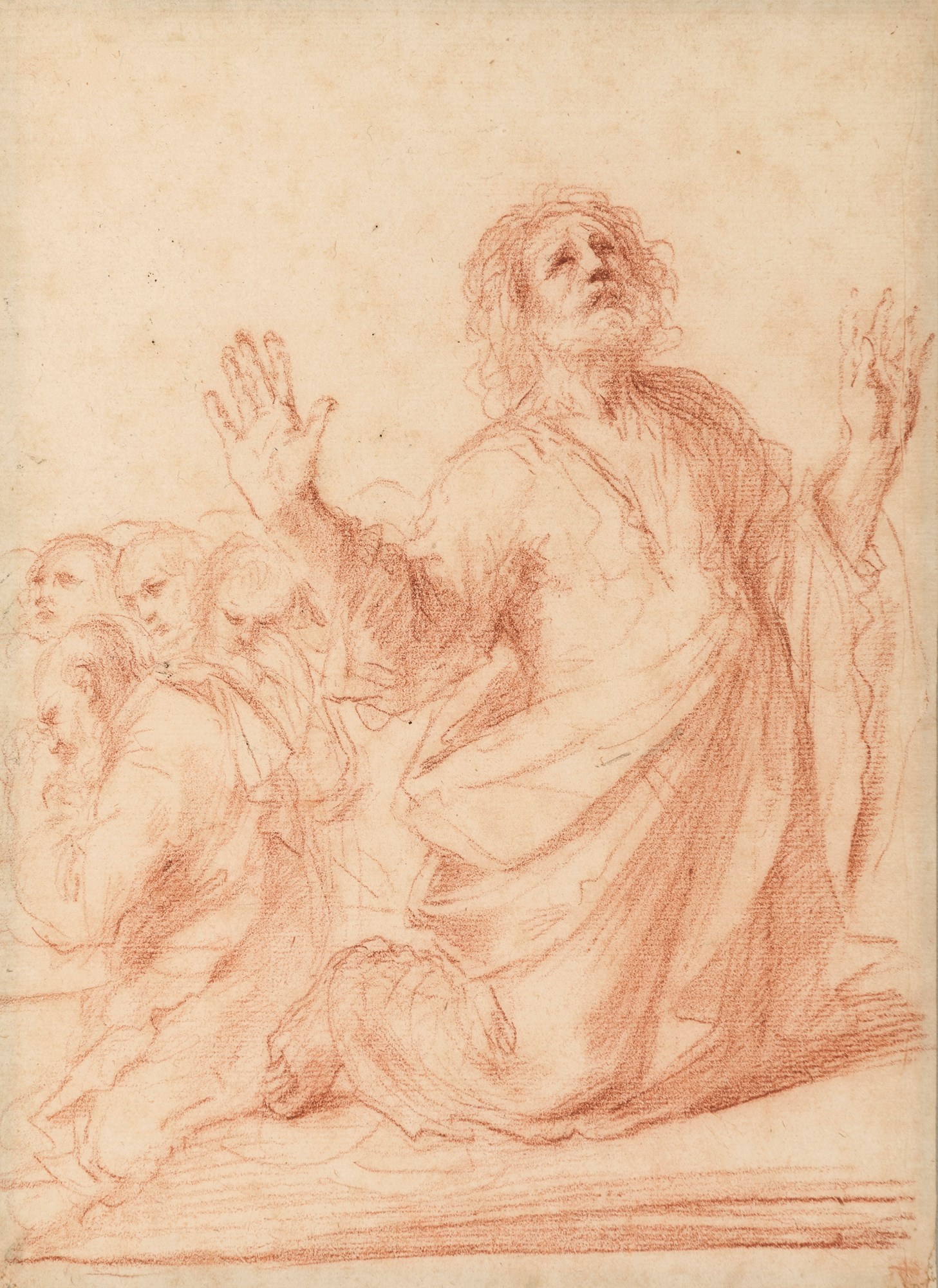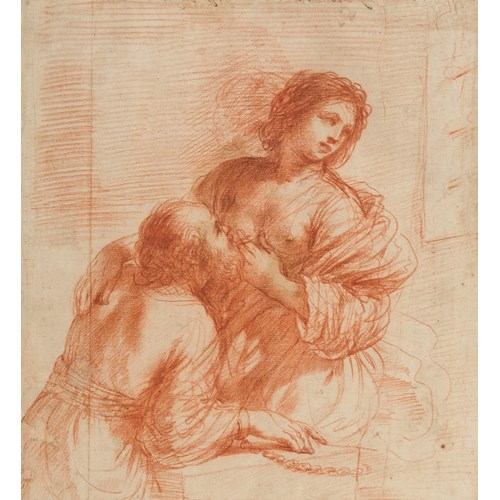Giovanni Francesco Barbieri GUERCINO
A Saint Kneeling in Prayer, with Other Figures Beyond
As David Stone has pointed out, with reference to both the Detroit painting and the present sheet, ‘one can hypothesize that instead of placing the apostles at the tomb in lontananza (in the distance), as Malvasia says and as Guercino actually painted them…along the lower edge of the canvas, the artist at first may have considered situating medium-size figures of the apostles in the middle distance and placing one full-size apostle (St. Peter?) in the foreground. The large apostle in [this] drawing stares transfixed at a miraculous sight overhead, which is clearly that of the ascendant Virgin, who has risen from the tomb where the other apostles – not yet aware of the assumption – have gathered to mourn…Owing to the higher price such a picture would inevitably have cost (since Guercino charged by the figure), it is possible that the client decided to eliminate the traditional scene from the foreground and to make do with just the Virgin, two large angels, and two putti (the equivalent of three and a half figures at 350 ducats.)’ The only preparatory study by Guercino that is undoubtedly for the Detroit picture is a double-sided red chalk sheet formerly in the collection of Mr. and Mrs. Morton Harris in New York and now also in the Detroit Institute of Arts. As Stone has pointed out of the recto of that drawing, one of the angels supporting the Virgin shows an interesting pentimento: ‘At first the angel on the left was looking down, as if he were observing the actions of the apostles below. However, almost certainly after the decision to remove the full-length apostles from the composition, Guercino redrew the angel’s head and body so that he now looks up towards the Virgin.’
Recently, however, a faithful painted copy of the Detroit painting, attributed to Guercino’s nephew and assistant Cesare Gennari, has been identified in the church of Sant’Antonio in Salsomaggiore, west of Parma. The Salsomaggiore painting includes more of the landscape at the bottom of the composition, which had been trimmed from the lower part of the Detroit canvas, and it is this landscape element that identifies the true subject of both the Salsomaggiore painting and the Detroit altarpiece as The Virgin of the Snow. The lower portion of the Salsomaggiore painting depicts the legendary miracle of the snowfall in August that marked the outlines of the future Basilica of Santa Maria Maggiore in Rome, with the patch of snow surrounded by numerous figures - the same figures previously assumed to be apostles in the Detroit painting – observing the miracle in amazement. Thus the angel noted by Stone in the preparatory drawing in Detroit can be understood to be gazing down at the snow on the ground.
The correct identification of the subject of the Detroit altarpiece as The Virgin of the Snow means that it cannot be the Assumption of the Virgin mentioned in the Libro dei Conti in 1650. Instead, the Detroit canvas can be identified with the only painting of The Virgin of the Snow listed in the Libro; a much later work commissioned by Guercino’s longstanding client Sebastiano Fabri, for which an initial advance payment or deposit was received on 7 May 1661. No other payments for this painting are recorded in the Libro, however, and the canvas seems to have remained in the artist’s studio after his death. The painting is next recorded in the 1690s, when it was being considered for purchase by Prince Johann Adam Andreas of Liechtenstein, but must have left the Casa Gennari before 1719, as it is not mentioned in the inventory undertaken that year.
Guercino’s 1650 painting of The Assumption of the Virgin, noted by both the Libro dei Conti and Malvasia as intended for an unknown church in Naples and long thought, incorrectly, to be the painting in Detroit, has very recently been identified by the scholar Massimo Pulini with a large altarpiece in the church of San Francesco in the city of Aversa, some twenty kilometres north of Naples. The Aversa painting is in very poor condition, and its composition is best judged in a reduced studio copy of the painting in the Catholic church of Our Lady of the Assumption in Latchford, a suburb of Warrington in Cheshire. The Aversa painting includes very small figures at the badly damaged bottom of the composition, which may be tentatively identified as the apostles. Thus Mahon’s supposition that the present sheet may have been a first idea for the apostles in the 1650 Assumption of the Virgin is still valid, albeit not for the painting in Detroit – which is now known to be eleven years later in date - but for the newly discovered Aversa painting instead.
The present sheet was among a large and important group of drawings in the Bouverie collection, described by the 18th century English collector Henry Reveley as ‘perhaps the finest collection of Guercino’s drawings in England…contained in about twelve volumes.’ Acquired in the 1740s from the Casa Gennari in Bologna by the British antiquarian John Bouverie (c.1722-1750), the collection contained numerous significant drawings by Guercino. As Nicholas Turner and Carol Plazzotta have noted, ‘drawings by Guercino with a Bouverie collection provenance share many features in common. They are in general in remarkably fine, even pristine condition, which implies, as Reveley was the first to observe, that they were very largely the drawings once preserved in the albums described by Malvasia as being in the master’s house…Although the drawings now at Windsor remain the single most impressive group of Guercino’s drawings in existence…[it contains fewer of] the more desirable pictorial composition studies in which the Bouverie collection was so rich.’
Provenance: By descent from the artist to his nephews, Benedetto and Cesare Gennari, the ‘Casa Gennari’, Bologna
By descent to Cesare Gennari’s grandson, Carlo Gennari, Bologna
Probably Francesco Forni, Bologna
Acquired in the 1740s by John Bouverie, Betchworth, Surrey
By descent to his sister, Anne Bouverie, Betchworth, Surrey, until 1757
Her son, Christopher Hervey, London and Betchworth, Surrey, until 1786
His aunt, Elizabeth Bouverie, Barham Court, Teston, Kent, until 1798
Bequeathed to Sir Charles Middleton, later 1st Baron Barham, Barham Court, Kent
By descent to his grandson, Charles Noel, 3rd Baron Barham and later 1st Earl of Gainsborough of the second creation
His son, Charles William Francis Noel, 3rd Earl of Gainsborough, Exton Park, Oakham, Rutland
Thence by descent to Anthony Gerard Edward Noel, 5th Earl of Gainsborough, Exton Park, Oakham, Rutland
His sale (‘The Property of the Rt. Hon. The Earl of Gainsborough, removed from Exton Park, Rutland’), London, Christie’s, 23 November 1971, lot 103 (bt. Baskett & Day for 600 gns.)
Baskett & Day, London, in 1972
Private collection, San Francisco.
Literature: Frederick J. Cummings, ‘The Assumption of the Virgin by Guercino’, Bulletin of the Detroit Institute of Arts, 1972, p.62, note 15; The Burlington Magazine, January 1973 [advertisement]; David M. Stone, Guercino: Master Draftsman. Works from North American Collections, exhibition catalogue, Cambridge, Ottawa and Cleveland, 1991, pp.131-135, no.58 (as The Apostles at the Tomb, and dated to the early 1650s); Sir Denis Mahon, Giovanni Francesco Barbieri il Guercino 1591-1666: Disegni, exhibition catalogue, Bologna, 1991 [pub. 1992], p.218, under no.140; Sir Denis Mahon, Guercino: Master Painter of the Baroque, exhibition catalogue, Washington, D.C., 1992, p.289, under no.49 (where dated c.1650); R. Ward Bissell, Andria Derstine and Dwight Miller, Masters of Italian Baroque Painting: The Detroit Institute of Arts, London, 2005, p.110, under no.34 (entry by Ward Bissell); Nicholas Turner, The Paintings of Guercino: A Revised and Expanded Catalogue raisonné, Rome, 2017, p.663, under no.373.
Exhibition: London, Baskett & Day, Exhibition of Drawings, 1972, no.9; Cambridge, Harvard University Art Museums, Ottawa, National Gallery of Canada, and Cleveland, Cleveland Museum of Art, Guercino: Master Draftsman. Works from North American Collections, exhibition catalogue, 1991, no.58.
More artworks from the Gallery






_T638203653817250220.jpg?width=500&height=500&mode=pad&scale=both&qlt=90&format=jpg)


